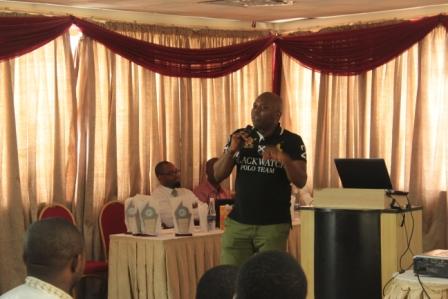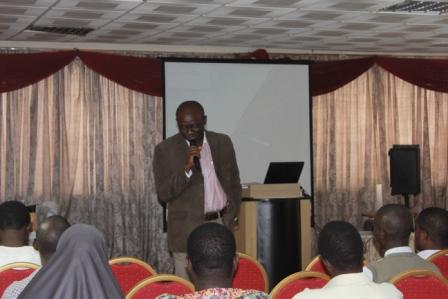Sagamite is a bachelors graduate from one of the UK’s elite universities after an early life in Nigeria. He is an experienced management consultant that has worked with firms in a diverse range of industries both in public and private sector. His experience provides him with a catalogue of versatile and arcane knowledge. His current interests include logical structure of opinions/arguments, entrepreneurship and human psychology. He prides himself on his organic, objective and independent thinking, so the audience should expect a significant number of his articles to be contra-popular belief. He is one of Nigeria’s leading objective-Contrarian thinkers about life’s generally accepted conventional wisdom.
Hey, are you looking at what I have up here, listening to what I am saying and do you understand it?
Those are part of the things you need to worry about when standing in front of people giving a presentation.
As you rise higher on the career ladder or as a big-time entrepreneur, or even as a leader in a non-commercial environment, one of the things that would increasingly become important to your success is the ability to influence a wide variety of audiences.
Presentation is one of the key tools used in influencing people. It is a way of getting your point across by standing in front of people and providing them with information, instructions or try to convince them to make a decision/see things from an angle you desire.
Now many presentations are a failure because most presenters do not have an understanding of the psychology behind getting that my article-opening question to be “Yes”. If you understand the art of presentation, you can become more effective in achieving this “Yes”.
There are loads of aspects that relate to successfully presenting material but I will not go into each and every one of them. I will cover the most critical but not widely known basics as an introduction.
Formats of presentation
Before going into the “art”, let us look at the formats of presentation that one could have. There are multiple possible dimensions to presentations.
You could have a non-presenter presentation (e.g. video), an interactive presentation (e.g. audiences allowed to ask questions and participate), a non visual presentation (think Steve Jobs or all these TED events) or a real life dramatisation presentation (yes, scenario playing to get your point across).
The dimensions you elect to use is really dependent on your type of audience, the complexity of your message, the time you have to present, the strength of the team creating the presentation, language/speech barriers and the emotion you want to arouse, so you should really be careful which format you choose when you want to do a presentation.

Cross section of audience at the Jarushub Career Conference
Audience type
Out of this dimensions, one that usually stands out to me, and which is more frequently a factor, is your type of audience.
Apart from generational/age of your type of audience which influence the format of a presentation, one other major categorisation that interests me is personality types.
The personality type of your audience plays a critical part in gaining and retaining their attention in a presentation. In the work environment you are likely to be presenting more to adults of a certain age range. One tool I like to use when presenting is theFour Working/Social Styles.
These four styles are Drivers, Expressives, Analytical and Amiable. I will not go into the detail of how this categorisation is created because of length of article and the aims of the article. I will just emphasis the role they play in presentations. There are many articles online to teach you how these four styles were created if you search online using the “Drivers, Expressives, Analytical and Amiable” keywords …………and I suggest you do.
I would even suggest you suspend reading this article at this point, go and do the search, read a bit (like half an hour) about these four styles and come back to continue reading my article so you fully understand.
Have you finished the research? …………Okay, I will continue.

An energetic presentation by Tope Fasua, FCA, at Jarushub Career Conference, September 2012
Presentation structure
When creating a presentation, it is very important to ensure you are addressing the needs of your audience.
Make sure that the structure of your presentation quickly and adequately satisfies the needs of each of your audience member based on their working style.
Drivers are abrasive, task-focused and results-orientated individuals. They want to know quickly what the objectives are and what is going to get done. They tend to be impatient people. Satisfy their desire first by ensuring your presentation highlights the major tasks/goals and how these are going to get done. Very short, very brief. Put it in the summary/introduction.
The next most impatient style are the Expressives. They are articulate, quick and visionary and want to see the big picture of how everything fits in and are interconnnected. To ensure they remain engaged in your presentation, in your next few slides after the summary/introduction section paint a picture of why the tasks/goals are important. How they fit into the overall vision and goals of the organisation that matters [to the audience].
After satisfying this two, you are on track. Now your presentation needs to tackle the Analyticals. Yes, they are patient. Very patient actually; but they are only patient because they need data and details. They want to see facts and figures that back up your claims. And they will scrutinise them! Analyticals are thoughtful, careful fact-oriented and precise. You need to get your facts right and all your backing figures on point because they are likely to scrutinise it. So follow up the presentation with how you arrived at your assertion about how the tasks/goals will be done, why they are important and why your way of doing it is the best. Bring many solid data to back it up if possible.

Simon Kolawole, former Editor of THISDAY newspapers, also presented at the conference
Then the nice guys/gals are next. The Amiables tend to be friendly and people-orientated. They would be very patient with you and even supportive, but they also need to know something: “how do these tasks/goals affect people and feelings?” Move your presentation to next satisfying their needs. Address how people will feel and make sure you show them you took that into consideration when defining your tasks/goals.
With such a structure, you will minimise the likelihood of many of your audience losing focus and being distracted. You are using a structure that exploits personality types and their patience and concentration aptitude.
What tends to happen is that once the Drivers and Expressives are satisfied, they tend to keep quiet till the end of the presentation without disrupting (i.e. as long as it is not too unnecessarily long, otherwise you go here am). They are the dominant ones and the most likely to disrupt if unhappy, so keeping them happy is important to ensure the flow.
Also note that most executives in profit-making/commercial establishments are mostly Drivers, followed by Expressives and Analyticals. Few are Amiables.
Presenting
Now to the presenting!
Due to length, lets leave that to my next article.
OTHER ARTICLES BY SAGAMITE
If you found this helpful, please share with others










[…] leading objective-Contrarian thinkers about life’s generally accepted conventional wisdom Continued from PART 1 When delivering the presentation, you need to tell a story that your audience can follow. […]